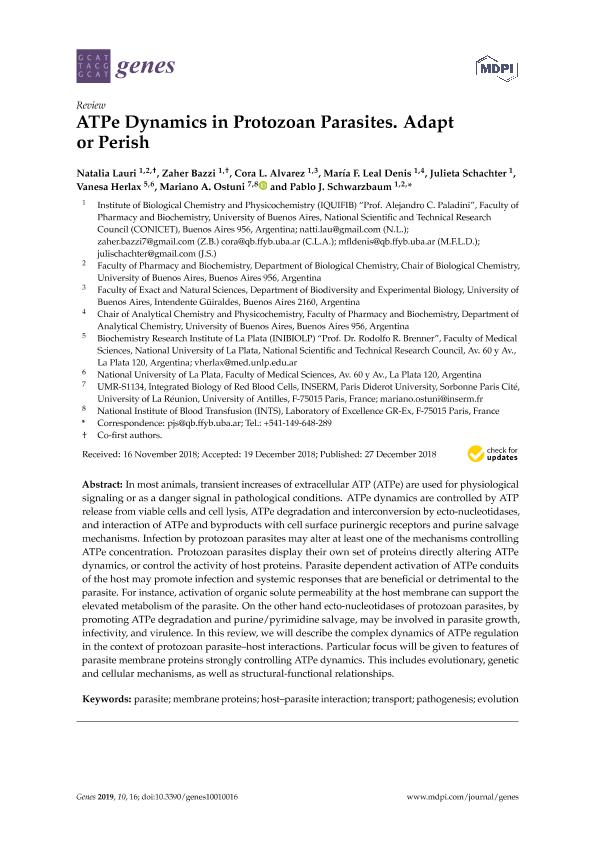Artículo
ATPe dynamics in protozoan parasites. Adapt or Perish
Lauri, Natalia; Bazzi, Zaher ; Alvarez, Cora Lilia
; Alvarez, Cora Lilia ; Leal Denis, Maria Florencia
; Leal Denis, Maria Florencia ; Schachter, Julieta
; Schachter, Julieta ; Herlax, Vanesa Silvana
; Herlax, Vanesa Silvana ; Ostuni, Mariano; Schwarzbaum, Pablo Julio
; Ostuni, Mariano; Schwarzbaum, Pablo Julio
 ; Alvarez, Cora Lilia
; Alvarez, Cora Lilia ; Leal Denis, Maria Florencia
; Leal Denis, Maria Florencia ; Schachter, Julieta
; Schachter, Julieta ; Herlax, Vanesa Silvana
; Herlax, Vanesa Silvana ; Ostuni, Mariano; Schwarzbaum, Pablo Julio
; Ostuni, Mariano; Schwarzbaum, Pablo Julio
Fecha de publicación:
27/12/2018
Editorial:
Multidisciplinary Digital Publishing Institute
Revista:
Genes
ISSN:
2073-4425
Idioma:
Inglés
Tipo de recurso:
Artículo publicado
Clasificación temática:
Resumen
In most animals, transient increases of extracellular ATP (ATPe) are used for physiological signaling or as a danger signal in pathological conditions. ATPe dynamics are controlled by ATP release from viable cells and cell lysis, ATPe degradation and interconversion by ecto-nucleotidases, and interaction of ATPe and byproducts with cell surface purinergic receptors and purine salvage mechanisms. Infection by protozoan parasites may alter at least one of the mechanisms controlling ATPe concentration. Protozoan parasites display their own set of proteins directly altering ATPe dynamics, or control the activity of host proteins. Parasite dependent activation of ATPe conduits of the host may promote infection and systemic responses that are beneficial or detrimental to the parasite. For instance, activation of organic solute permeability at the host membrane can support the elevated metabolism of the parasite. On the other hand ecto-nucleotidases of protozoan parasites, by promoting ATPe degradation and purine/pyrimidine salvage, may be involved in parasite growth, infectivity, and virulence. In this review, we will describe the complex dynamics of ATPe regulation in the context of protozoan parasite–host interactions. Particular focus will be given to features of parasite membrane proteins strongly controlling ATPe dynamics. This includes evolutionary, genetic and cellular mechanisms, as well as structural-functional relationships.
Archivos asociados
Licencia
Identificadores
Colecciones
Articulos(INIBIOLP)
Articulos de INST.DE INVEST.BIOQUIMICAS DE LA PLATA
Articulos de INST.DE INVEST.BIOQUIMICAS DE LA PLATA
Citación
Lauri, Natalia; Bazzi, Zaher; Alvarez, Cora Lilia; Leal Denis, Maria Florencia; Schachter, Julieta; et al.; ATPe dynamics in protozoan parasites. Adapt or Perish; Multidisciplinary Digital Publishing Institute; Genes; 10; 1; 27-12-2018; 1-27
Compartir
Altmétricas



